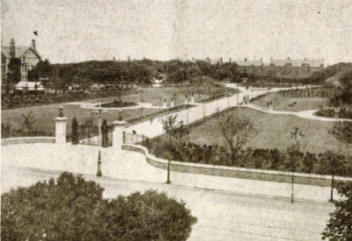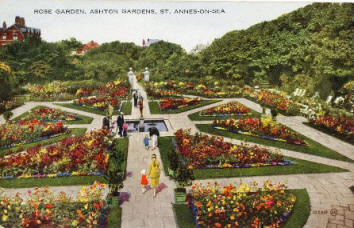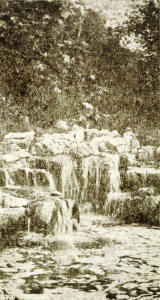Description of the Gardens.
Nearly £20,000 has been spent in making the beautiful gardens, which are now a
magnificent asset to the town. Every natural feature of the original Gardens has been preserved,
and a pleasant and successful innovation is the breaking away from formality—we have gardens, not a
park. The fine trees have been retained, giving the gardens a leafiness and shade which is lacking
in other parts of-the town.

The main approach is from Clifton Drive through stately entrance gates; and
where, three years ago, was a builder's yard there are now beautiful lawns and flower beds.
 From North Drive the carriage way is 24ft. wide, with
rose bed borders cut in the verge of turf. Along the drive—an avenue of lime trees—are about
1,000 rose trees. At each side of the approach a fourteen feet sloping terrace leads down to a
broad expanse of turf. This terrace is broken on each side-by a flight of ornamental steps,
leading to oval beds of rhododendrons and standard roses. From North Drive the carriage way is 24ft. wide, with
rose bed borders cut in the verge of turf. Along the drive—an avenue of lime trees—are about
1,000 rose trees. At each side of the approach a fourteen feet sloping terrace leads down to a
broad expanse of turf. This terrace is broken on each side-by a flight of ornamental steps,
leading to oval beds of rhododendrons and standard roses.
The raised banks which flank the lawns are graced with a sweeping festoon of
roses, and behind these are planted clumps of herbaceous plants, now making a beautiful display of
bloom. Behind these again, and hiding the boundary walls, arc mixed shrubs and forest trees, which
will give a background of green and throw into prominence a glorious profusion of bloom. The drive
leads up a flight of steps to a mound covered with pretty flowering Shrubs.
 Ascending the mound by a Japanese stair, a pretty woodland walk leads to
the Old English Rose Garden and Rock and Water Garden. The rose garden has charmed everyone.
Oval shape, with square piers at each end, it is the sunspot of the Garden, and presents a
charming vision of colour. Ascending the mound by a Japanese stair, a pretty woodland walk leads to
the Old English Rose Garden and Rock and Water Garden. The rose garden has charmed everyone.
Oval shape, with square piers at each end, it is the sunspot of the Garden, and presents a
charming vision of colour.
Choice varieties of roses are planted in masses in triangular beds, with
herbaceous plants in the circular ends. A lily pond, with a small fountain occupies the centre. The
paths are flagged, and round the garden is a low terraced wall with seats, with an ornamental rose
fence background made of ship's oak.
In this garden the following appropriate lines have been cut in a stone:
The kiss of the sun for pardon,
The song of the bird for mirth;
You are nearer God's heart in a garden than anywhere else on
earth.

From the Rose Garden a short path leads to the Rock and Water Garden which is
the work of Messrs. Pulham and Sons, of London. This garden is a reintroduction of Nature, and
something new in public gardens. It is, in fact, more like a nobleman's private garden than a park.
The treatment is free, and great attention has been given to obtain the effect of distance in every
vista.
About 500 tons of weather-worn rock have been brought from near Grange and has
been arranged to give the effect of the natural strata, gradually sloping towards the sea with
outcrops of stone. Plants and shrubs are introduced as if in natural habits, and the whole
conception has been to give age as well as beauty.
 One of the first effects which enraptures the visitor is the waterfall
and Cascade. The water falls over layers of water-worn rock, a direct fall in the centre, with
a cascade on the left side. The water gives the appearance of falling from a "beck," and is
received into a winding lake made in a bed of glacier stone. This lake is over 200 feet long
and is bridged by a quaint one-span low bridge. An island, wooded with willows and a bold
promontory with ramblers climbing over its face, are interesting features in the view from the
bridge, whilst further in the distance is a background of trees and shrubs hiding the boundary
walls and houses. Grass glades shelve down to the shores of the lake, which is prettily
fringed with irises. One of the first effects which enraptures the visitor is the waterfall
and Cascade. The water falls over layers of water-worn rock, a direct fall in the centre, with
a cascade on the left side. The water gives the appearance of falling from a "beck," and is
received into a winding lake made in a bed of glacier stone. This lake is over 200 feet long
and is bridged by a quaint one-span low bridge. An island, wooded with willows and a bold
promontory with ramblers climbing over its face, are interesting features in the view from the
bridge, whilst further in the distance is a background of trees and shrubs hiding the boundary
walls and houses. Grass glades shelve down to the shores of the lake, which is prettily
fringed with irises.
Over 6,000 Rose Trees.
There is a wonderful variety of flowers and shrubs in the Ashton Gardens. The
chief feature is the roses which cannot be introduced on the Promenade on account of the high
winds. Over 6,000 rose trees have been planted in the gardens, and in summer time they give an
atmosphere of beauty. Rhododendrons and many other flowering shrubs, new to St. Annes, have been
introduced, and in a few years time the Ashton Gardens will be unsurpassed in the North of
England.
Tennis and Bowls.
On the recreative side the provision is equally extensive. There are 13 tennis
courts, with ample space for more. There are six courts on which the St. Annes Club play at
present. Behind these four more have been laid, and three en-tout-cas courts facing St. George's
Road. A large bowling green, 120 feet square, with bowl-house, has been laid out between the St.
George’s Road entrance and the Empire, and, like the tennis courts, this is surrounded by a 9 feet
path, with a border of shrubs, backed by a rubble wall covered with climbers. A games' pavilion,
equipped with billiard table and a verandah, overlooks the tennis courts.
At the St. George's Road entrance the Ashton Pavilion has been erected to
accommodate a ladies' orchestra. The Pavilion can be thrown open in summer, and in winter can be
used for dances and entertainments. Provision is made for serving afternoon teas on the lawns.
In the laying-out of the Gardens the expert knowledge of the Chairman of the
Council (Coun Leigh) has been of great value. He has devoted himself without stint, to the service
pf the town. He has been ably assisted by Coun. J. W. Hallam (chairman of the Ashton Gardens
sub-committee), which also includes Couns. Eyre, Hill, Parr, Rothwell and J. H. Taylor. Upon Mr.
Kitchen (head gardener) much of the work has devolved, and he has carried it out with the same
skill and care which has made St. Annes Esplanade famous for its floral beauty. Mr. J. S. Sawdon,
A.M.I.C.E., is also responsible for much of the substantial work in the scheme which has given St.
Annes a magnificent play-ground and a glorious beauty spot.
Lytham St.Annes Express, 1916
|